 Open Access
Open Access
ARTICLE
Bayes-Q-Learning Algorithm in Edge Computing for Waste Tracking
1 Department of Computer Science and Engineering, Dr. NGP Institute of Technology, Coimbatore, 641048, India
2 Department of Information Technology, Sri Krishna College of Technology, Coimbatore, 641042, India
3 Department of Computer Science, College of Computers and Information Technology, Taif University, P. O. Box 11099, Taif, 21944, Saudi Arabia
4 Department of Information Technology, College of Computers and Information Technology, Taif University, Taif P.O. Box 11099, Taif, 21944, Saudi Arabia
5 Department of Mathematics, Faculty of Science, Mansoura University, Mansoura, 35516, Egypt
6 Department of Computational Mathematics, Science, and Engineering (CMSE), Michigan State University, East Lansing, MI, 48824, USA
* Corresponding Author: Mohamed Abouhawwash. Email:
Intelligent Automation & Soft Computing 2023, 36(2), 2425-2440. https://doi.org/10.32604/iasc.2023.033879
Received 30 June 2022; Accepted 14 October 2022; Issue published 05 January 2023
Abstract
The major environmental hazard in this pandemic is the unhygienic disposal of medical waste. Medical wastage is not properly managed it will become a hazard to the environment and humans. Managing medical wastage is a major issue in the city, municipalities in the aspects of the environment, and logistics. An efficient supply chain with edge computing technology is used in managing medical waste. The supply chain operations include processing of waste collection, transportation, and disposal of waste. Many research works have been applied to improve the management of wastage. The main issues in the existing techniques are ineffective and expensive and centralized edge computing which leads to failure in providing security, trustworthiness, and transparency. To overcome these issues, in this paper we implement an efficient Naive Bayes classifier algorithm and Q-Learning algorithm in decentralized edge computing technology with a binary bat optimization algorithm (NBQ-BBOA). This proposed work is used to track, detect, and manage medical waste. To minimize the transferring cost of medical wastage from various nodes, the Q-Learning algorithm is used. The accuracy obtained for the Naïve Bayes algorithm is 88%, the Q-Learning algorithm is 82% and NBQ-BBOA is 98%. The error rate of Root Mean Square Error (RMSE) and Mean Error (MAE) for the proposed work NBQ-BBOA are 0.012 and 0.045.Keywords
The medical waste management system is an important decision-making problem to protect our environment. If medical waste is not disposed of properly, it creates a high risk to the health condition of human beings and also spoils the environment [1]. Medical waste management is used to manage waste from health centers, transportation, and disposal of medical waste, and its processing cost is high. This paper presents an efficient medical waste management system using an efficient Naive Bayes classifier algorithm and Q-Learning algorithm in decentralized edge computing technology with a binary bat optimization algorithm (NBQ-BBOA). It reduces the cost of transportation, minimizes the time in processing, has reliable data speed, high security, and transparency, is auditable for the solution of the supply chain, and provides cheap medical equipment waste management. The Ethereum-based decentralized storage is used to store large amounts of information in a secure manner and transfer data through the supply chain of medical equipment and manage the medical waste system.
Monitoring of the generation of medical waste from health care centres or hospitals and compliance of health care centres using edge computing technology can efficiently handle the medical equipment waste. The medical equipment data and transactions of usage data are stored on the edges and are accessible to the physicians or staff in the health care centre through the supply chain. The decentralized storage of edge computing increases security, trust, and easily accessible data [2–4]. The category of medical wastage in the aspects of hazardousness includes infectious medical wastage, general medical waste or non-hazardous, pharmaceutical, and chemical wastage [5]. The disposal of pharmaceutical waste is traditionally carried out by burning or non-burning methods. This method of disposal of waste contains 15% hazardous waste and the remaining 85% is considered general waste [6]. A huge amount of pharmaceutical waste is found in streams, waterways, and groundwater, which affects the climate and water [7]. The main contribution of this paper is,
1. Implementing an Ethereum edge computing-based method for tracking the medical equipment supplier and disposal of medical equipment wastage using a supply chain.
2. Develop a smart contract with naïve Bayes and Q-Learning algorithms in the supply chain.
3. Implementing decentralized storage provides more security, trustfulness, and transparency.
4. Developing a binary bat optimization algorithm
The paper has been organized as follows: Section 2 describes the literature review, Section 3 implements an effective medical waste management system, Section 4 discusses the experimental results, and Section 5 concludes the paper with future directions.
The World Health Organization (WHO) defines pharmaceutical wastage as including unused medicines, expired vaccines, and spilled items that are disposed of properly [8]. Nowadays, the wastage of pharmaceuticals has increased in huge numbers because of the overproduction of medicine, the increased number of patients, and the poor health conditions of humans. This leads to an increasing wastage level of expired medicine or medical equipment, unused medicine, and the cost of disposal of medical equipment [9]. This paper proposes managing medical equipment waste using edge computing technology in the supply chain.
In the health care field, edge computing technology securely tracks medical equipment and medicines from manufacturer or distributor to health care center. The coinage computing approach tracks and traces the medicines through the supply chain method. It performs the operations of handling manufacturers, pharmacies, distributors, and drug in-takers. These transactions are stored in edge computing to identify the supplier or manufacturer of medical equipment [10]. To provide assurance of drug safety, purchasing medical equipment from an authorized person and maintaining the quality of medical equipment [11] is necessary.
In the paper [12], the authors introduce the smart waste management system in which the waste producer’s service cost is charged based on price estimation. It also includes IoT for monitoring and collecting data about the location of the waste bin and measuring the quantity of waste collected in the bin. The electronic waste management system was implemented using an Ethereum-based system which includes compliance and guidelines for the disposal of waste in electrical and electronic equipment (EEE). The main services of EEE are as a manufacturer, distributor, and consumer of medical equipment. Using smart contracts, we can report and record the disposal of EEE waste to the waste collector [13]. Table 1 shows a survey of literary works on the waste management system.

There are many techniques used in wastewater management, but the prediction accuracy is still not satisfactory to authorities. Medical equipment wastage analysis needs an intelligent learning platform. So in this work, we use Naïve Bayes with Q-learning, which is comparatively better than other techniques.
3 Proposed Environment Waste Management Methodology
Managing medical equipment suppliers and medical wastage is done in this work by an efficient Naive Bayes classifier algorithm [28] and Q-Learning algorithm [29–32] in decentralized edge computing technology with binary bat optimization algorithm (NBQ-BBOA). The architecture of the proposed work is given in Fig. 1. The process of this proposed work is divided into four components. They are; Registration authority, Ethereum edge computing with smart contracts and decentralized storage [33], medical waste management in the supply chain [34–37] finally, implementation of proposed work in the edge computing technique.

Figure 1: Architecture of medical wastage tracking
Drug and medical equipment suppliers registered their roles and license in the supply chain of medical waste delivery management systems [38–41]. And also, they should comply with rules and regulations. If the supplier is non-complying with the rules and regulations, then their license will be suspended by the registration authority [42].
A smart contract is an agreement between a medical equipment supplier and a medical center or healthcare professional in the form of rules. They run on edge computing, so they are stored on a public database and cannot be changed [43–49]. We implement three major contracts in this work, including the registration smart contract, medical equipment orders smart contract, and medical waste handler smart contract. All these smart contracts are implemented in the supply chain of the medical waste management system. Fig. 2 shows the sequence diagram of three smart contracts with the supply chain [50–54].

Figure 2: Sequence diagram of smart contracts
Distributed Storage
Medical equipment details and their requirements for treatment and medical waste details are stored in the distributed storage system on the edge computing ledger. To overcome the issue of scalability in edge computing, in this work, distributed storage is used.
3.3 Medical Waste Management in Supply Chain
In the medical waste management system [55,56], each distributor and health care centre is involved in the supply chain with monitoring, tracing, handling, and shipment of waste without spoiling the environment. The key components of the supply chain [57] in medical waste management are manufacturing medical equipment, distribution of medical equipment, medical centres, collection of medical waste, and segregation of medical waste [58].
3.3.1 Manufacturing of Medical Equipment
The medical manufacturer is used to manufacture the currently needed medical equipment and store the details of the equipment name, cost, manufacturing date, and details of the manufacturer in the edge nodes. The manufacturer finds a trusted supplier of raw materials and places the order for raw materials. Then they manufacture the medical equipment. Manufacturers should genuinely display the license details of medical equipment publicly.
3.3.2 Distributor of Medical Equipment
The responsibility of medical equipment distributors in the supply chain is to take a survey about the demand for medical equipment in the medical field, purchase the medical equipment from the registered manufacturers, and supply it to the registered healthcare centers. The distributor must have a valid license to purchase and supply medical equipment.
Healthcare centres purchase medical equipment from manufacturers or distributors. After using it, the waste is stored in the storage room safely. The waste handlers segregate the waste and pack it safely in a separate bag.
3.3.4 Medical Wastage Transportation
The collected medical waste from the health care centre is shipped to the medical waste treatment centre for recycling and disposal.
3.4 Implementation of Effective Waste Management System
The smart contract implementation in the supply chain includes the registration smart contract, medical equipment orders smart contract, and medical waste handler smart contract. This work implements the Naive Bayes classifier and Q-Learning algorithm for placing orders for the most in-demand medical equipment. It implements a binary bat optimization algorithm (NBQ-BBOA) to get the optimized solution. This algorithm is implemented in four different concepts: placing the medical equipment order; updating the requirements of medical equipment; sending requests for transporting the waste and monitoring and storing the medical waste safely.
The Naive Bayes classifier is reliable and handles various concepts ineffectively. In the Naïve Bayes algorithm, prior probability is calculated by using the probability of demand for medical equipment based on its market demand. For example,
This probability is used for future prediction of manufacturing medical equipment. This algorithm predicts the demand for medical equipment based on the maximum value among the groups in Eq. (1)
where A and B are the probability of demand for medical equipment.
where A is the group variable and A is the demand for the medical equipment of several items needed.
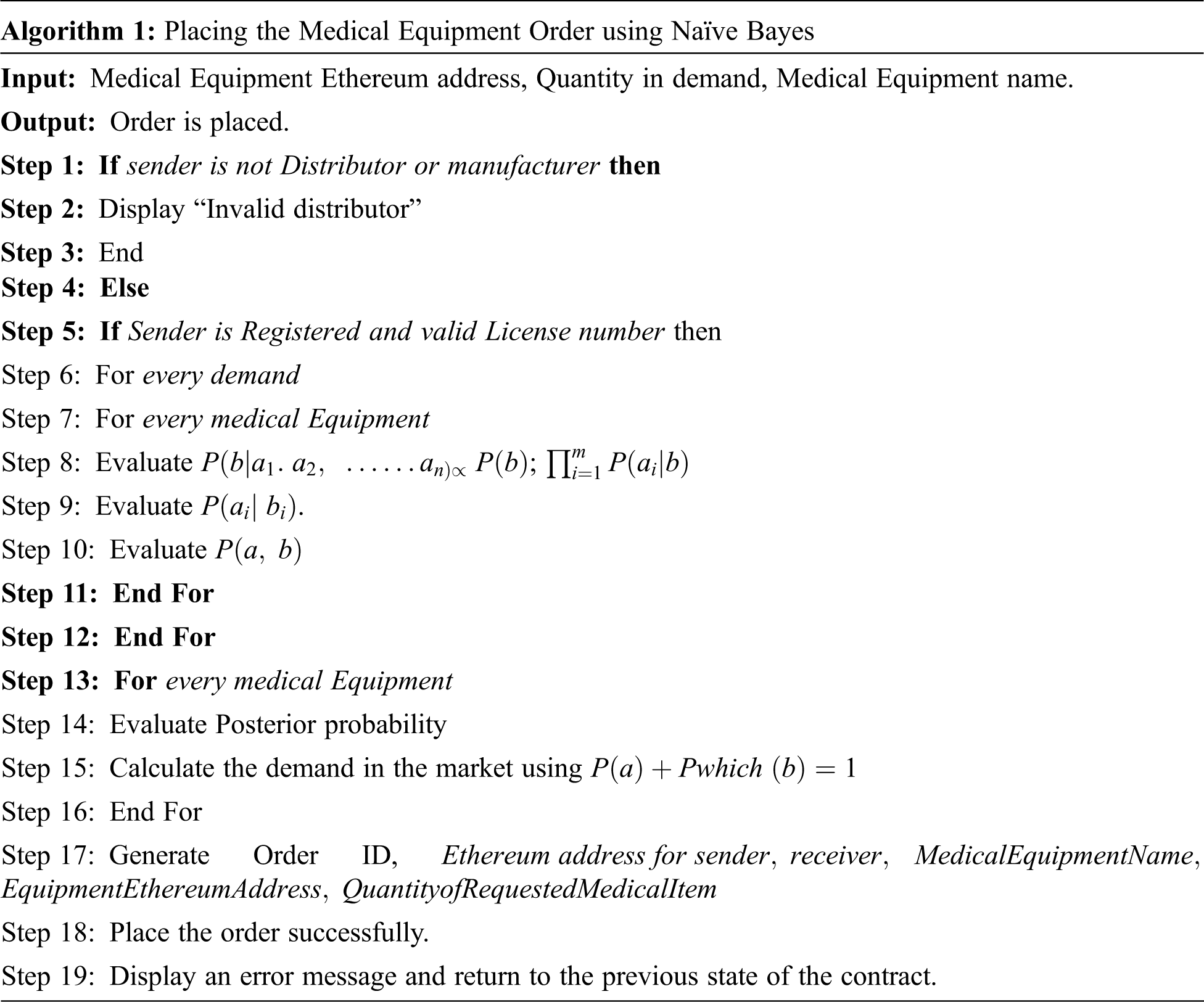
The procedure of Algorithm 1 is implemented to place an order for medical equipment requests from the health centre. It needs the sender to provide the Ethereum address of the manufacturer or distributor with the required quantity of medical equipment and also the name of the medical equipment. Algorithm 2 represents the distribution of medical equipment to the health care centre.

Algorithm 2 describes functionalities of selling the medical equipment to the health care centre based on their demand. The Selling process is done only to the registered manufacturers and distributors.
The highlights of Algorithm 3, Optimal Policy, are directly addressed in Q-Learning. The learning rate is set at a value between 0 and 1. If the set value is 0, nothing is learned and never updates the Q-values. If the set value is 1, a learning process occurs. The agent of the Q-Learning algorithm controls the consumption of medical waste in the health centre. The agent observed the state of each medical waste in the house and took action, estimating the immediate reward. In this way, an agent observed the maximum reward.
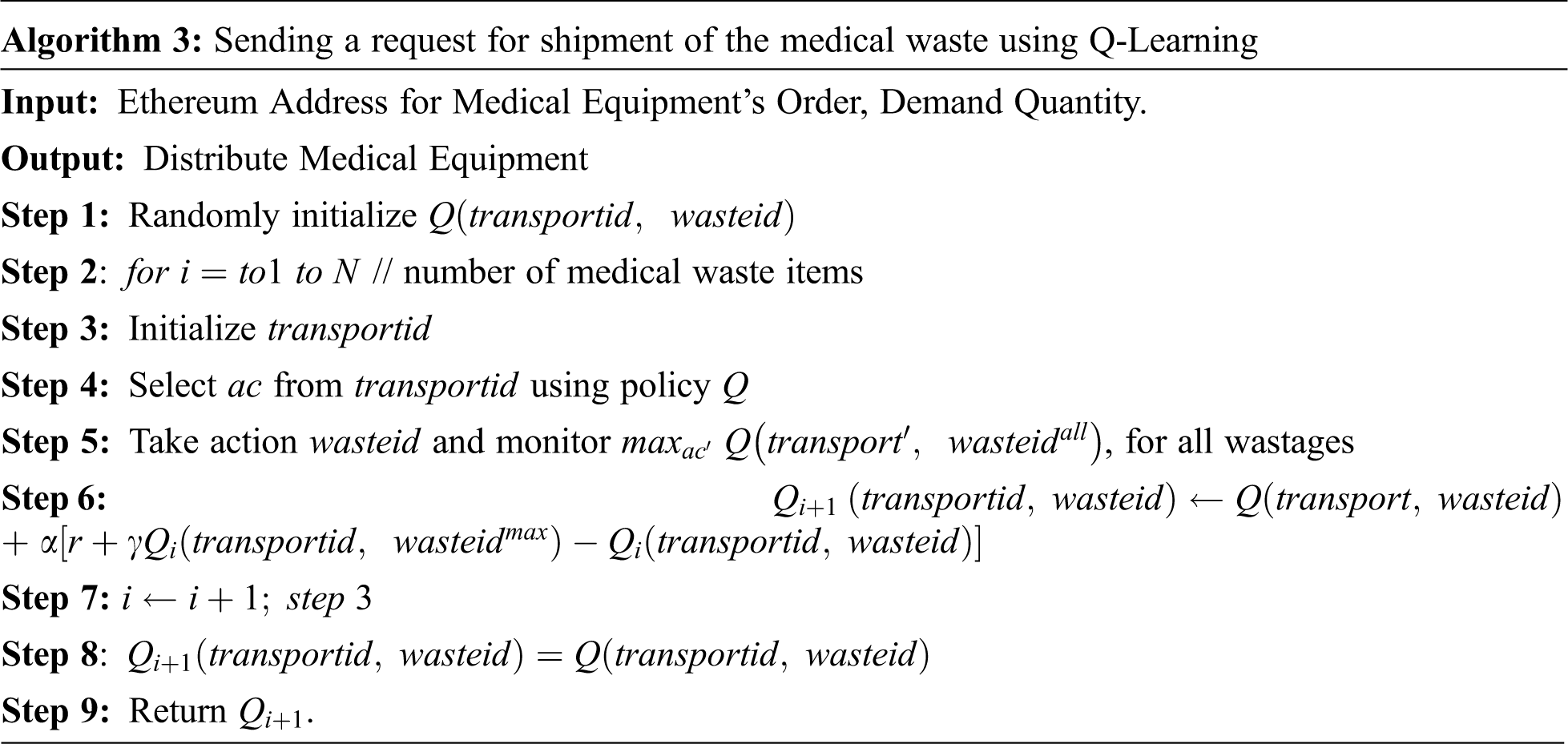
3.4.3 Binary Bat Optimization Algorithm
The binary bat optimization algorithm performs the task in the discrete search space. The search space of the Binary Bat Algorithm is restricted to 0’s and 1’s. To find the optimal solutions, the algorithm chooses potential outcomes from Naïve Bayes and Q-Learning algorithms in medical waste management. The transfer function of Binary Bat algorithm is given in Eq. (3):
Here, i is the particle and
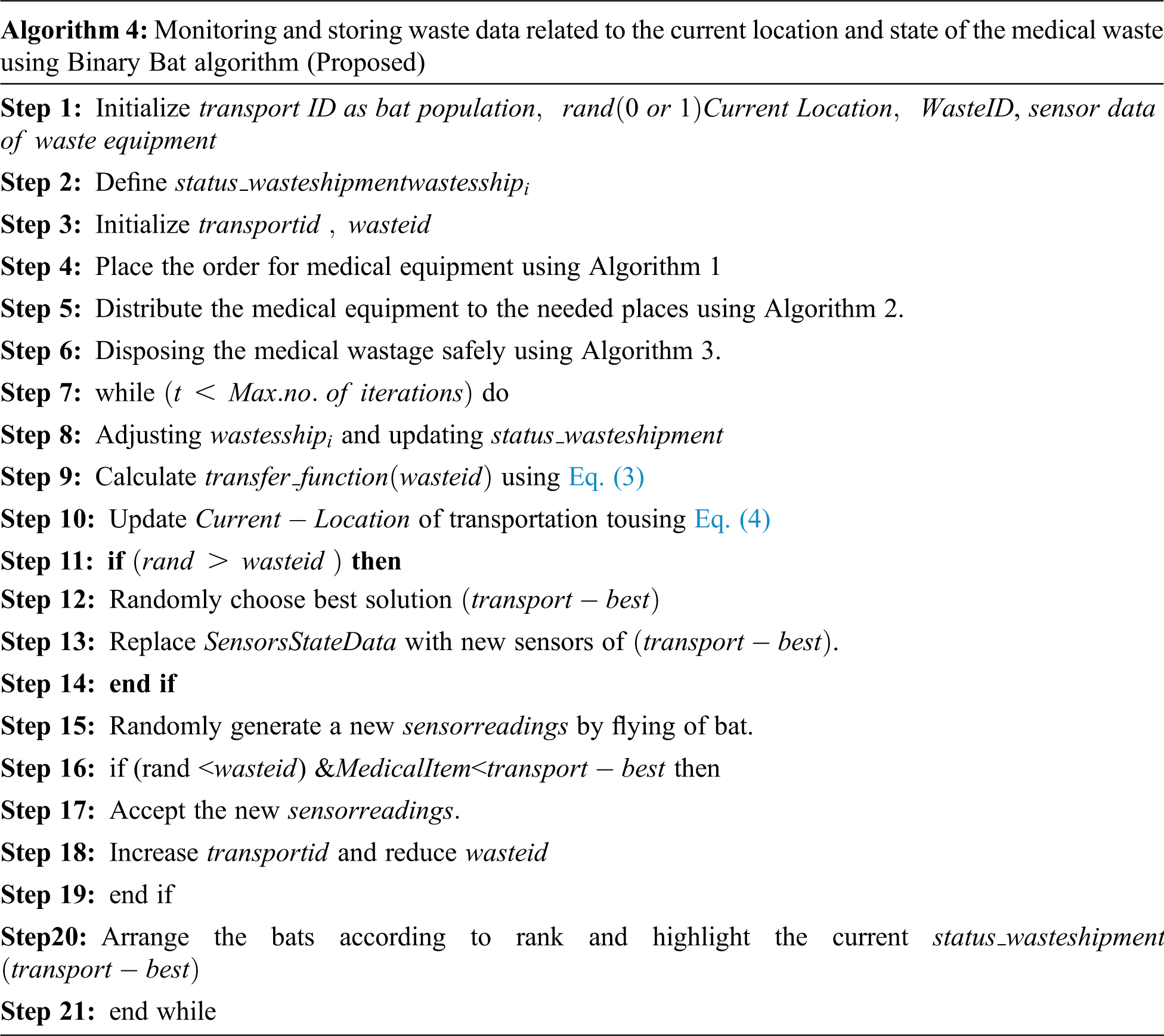
The highlights of Algorithm4 are the actions performed by sending requests to get the medical equipment and having the registered distributor send the medical equipment to the required places. After using the medical equipment, waste is collected and safely disposed of. Before uploading the waste, the system verifies the current status of the waste shipment. After this verification is completed, it allows the transporter to periodically upload the waste shipment’s location through the chain waste container’s state until it reaches the waste disposable unit.
Many pieces of medical equipment are designed for single use only. In that case, dispose of it immediately after its use. The medical waste generated from health care centres, medical laboratories, and hospitals must be handled carefully because it may spoil the environment. This medical waste needs to be recycled or disposed of in an efficient manner. In this work, an efficient approach is implemented in the supply of medical equipment to the health care centre using a supply chain concept and also disposes of the medical wastage. This work is based on three smart contracts and implements the Nave Bayes algorithm and Q-Learning concept integrated with the decentralised storage of Ethereum edge computing technology in the disposal of medical waste. These algorithms are analysed using performance metric measures of sensitivity, specificity, and accuracy. Positive likelihood, negative likelihood helps to analyse medical waste management, calculate the root mean square error (RMSE), which is given in Eqs. (6)–(15). An IoT-based survey and ideology for medical data collection were learned.
Table 2, shows that performance metric measures of medical wastage management algorithms.

The Table 2 for the sensitivity rate of the NBQ-BBOA (Proposed) algorithm (93.8%) is better than Naïve Bayes (86.3%) and Q-Learning (89.6%). NBQ-BBOA outperforms other algorithms with a specificity of 95.2%. For PLR value, proposed work NBQ-BBOA has better performance at 10.22. In the NLR rate, NBQ-BBOA got 0.043 compared with Naïve Bayes and Q-Learning. Fig. 3 shows that accuracy in the execution of proposed work.
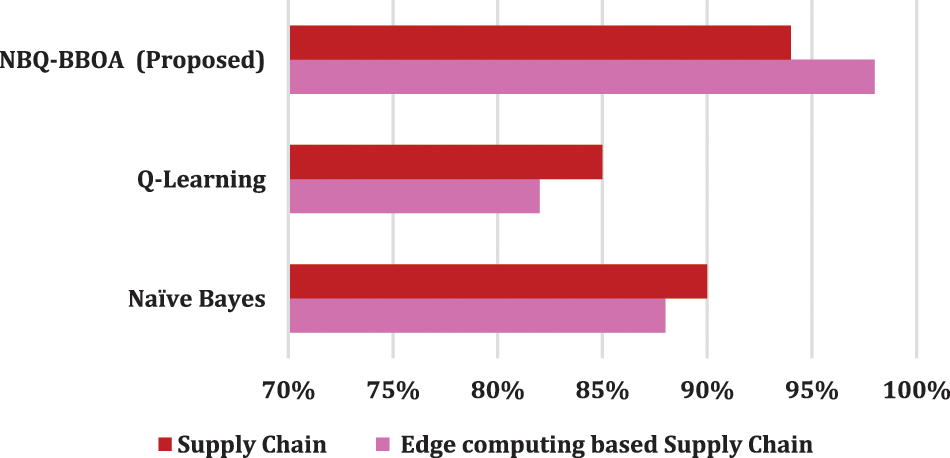
Figure 3: Accuracy
For implementing the accuracy rate with the concept of edge computing based in supply chain and without edge computing-based supply chain are evaluates and our proposed algorithm gives the better accuracy. Table 3 shows that comparison of our proposed work with existing parameters in wastage concepts.

Table 3 shows the benefits of our proposed work compared with existing concepts in the Ethereum-based decentralized storage method for handling the large-sized medical waste management system. And also, it shows that fast access provides security and automatic execution of smart contracts. Fig. 4 shows the F-score of Naïve Bayes, Q-Learning, and NBQ-BBOA (Proposed) algorithms.
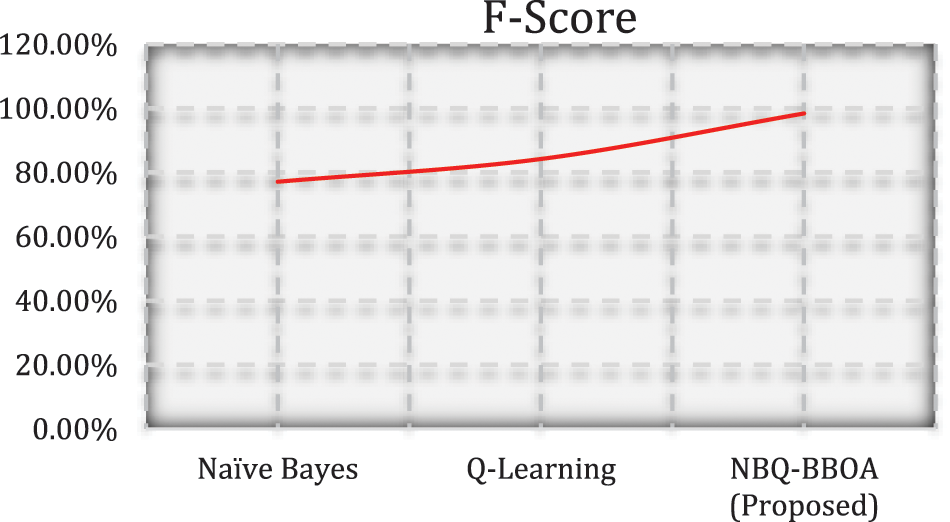
Figure 4: F-Score
In the evaluation of F-score value our proposed work gives better performance than existing algorithm. Using Eqs. (8) & (9), Table 4 shows that performance prediction of error rate.

From Table 4, it seems that our proposed work provides better improvement in terms of performance in the area of prediction in the error rate. Table 5 shows that computation time in (ms) is needed for doing the sequence of operations in the medical waste management system.

The above Table 5 shows the computation time taken for doing a sequence of operations in the medical waste management system. Our proposed work shows that less computation time is spent in executing a sequence of operations.
This paper aimed to develop an efficient medical waste management system in the supply chain using edge computing technology. The proposed NBQ-BBOA provides reliability, high security, transparency, and auditable solutions for supply chain and waste medical equipment management when compared with the existing algorithm. From the result, we concluded that our NBQ-BBOA produces a better system for supply chain and medical waste management systems. The Nave Bayes algorithm has an accuracy of 88%, the Q-Learning algorithm has an accuracy of 82%, and the NBQ-BBOA algorithm has an accuracy of 98%. The RMSE and MAE error rates for the proposed work NBQ-BBOA are 0.012 and 0.045, respectively. The computation time for performing the sequence of operations in the medical equipment wastage management system in our proposed work NBQ-BBOA got less computation time. In future work, the development of this waste management system will be implemented with a meta-heuristics algorithm. The limitation of the study is that Q-learning takes more time initially, which has to be considered for future research.
Acknowledgement: Authors would like to thank for the support of Taif University Researchers Supporting Project number (TURSP-2020/10), Taif University, Taif, Saudi Arabia.
Funding Statement: Taif University Researchers are supporting project number (TURSP-2020/10), Taif University, Taif, Saudi Arabia.
Conflicts of Interest: The authors declare that they have no conflicts of interest to report regarding the present study.
References
1. E. S. Windfeld and M. S. Brooks, “Medical waste management: A review,” Journal of Environmental Management, vol. 163, no. 3, pp. 98–108, 2015. [Google Scholar]
2. S. Saberi, M. Kouhizadeh, J. Sarkis and L. Shen, “Blockchain technology and its relationships to sustainable supply chain management,” International Journal of Production Research, vol. 57, no. 7, pp. 2117–2135, 2019. [Google Scholar]
3. R. W. Ahmad, K. Salah, R. Jayaraman, I. Yaqoob, S. Ellahham et al., “Blockchain and COVID-19 pandemic: Applications and challenges,” IEEE TechRxiv, vol. 13, no. 3, pp. 1–12, 2020. [Google Scholar]
4. I. Yaqoob, K. Salah, R. Jayaraman and Y. A. Hammadi, “Blockchain for healthcare data management: Opportunities, challenges, and future recommendations,” Neural Computing and Applications, vol. 23, no. 4, pp. 1–16, 2020. [Google Scholar]
5. W.H.O, “Safe management of wastes from health-care activities: A summary,” World Health Organization, 2017, [Online]. Available: https://www.who.int/water_sanitation_health/publications/safe-management-of-wastesummary/en/. [Google Scholar]
6. WHO, “Health care waste,” World Health Organization, [Online]. Available: https://www.who.int/news-room/fact-sheets/detail/healthcare-waste 2020. [Google Scholar]
7. S. Bungau, D. M. Tit, K. Fodor, G. Cioca, M. Agop et al., “Aspects regarding the pharmaceutical waste management in Romania,”Sustainability, vol. 10, no. 4, pp. 25–34, 2018. [Google Scholar]
8. WHO, “Guidelines for safe disposal of unwanted pharmaceuticals in and after emergencies,” World Health Organization, 1999 [Online]. Available: https://www.who.int/water_sanitation_health/medicalwaste/unwantpharm.pdf. [Google Scholar]
9. T. Hui, B. Mohammed, P. Donyai, R. Mcrindle and R. Sherratt, “Enhancing pharmaceutical packaging through a technology ecosystem to facilitate the reuse of medicines and reduce medicinal waste,” Pharmacy, vol. 8, no. 2, pp. 58–67, 2020. [Google Scholar]
10. J. H. Tseng, Y. C. Liao, B. Chong and S. W. Liao, “Governance on the drug supply chain via gcoin blockchain,” International Journal of Environmental Research and Public Health, vol. 15, no. 6, pp. 1055–1065, 2018. [Google Scholar]
11. R. Kumar and R. Tripathi, “Traceability of counterfeit medicine supply chain through blockchain,” in Proc. COMSNETS, Bengaluru, India, pp. 568–570, 2019. [Google Scholar]
12. M. Lamichhane, “A smart waste management system using IoT and blockchain technology,” Tech. Rep, Master Thesis, ITMO University, Russia, 2017. [Google Scholar]
13. N. Gupta and P. Bedi, “E-Waste management using blockchain based smart contracts,” in Proc. ICACCI, IEEE, Bangalore, India, pp. 915–921, 2018. [Google Scholar]
14. M. Abdallah, S. Hamdan and A. Shabib, “A multi-objective optimization model for strategic waste management master plans,” Journal of Cleaner Production, vol. 284, no. 3, pp. 124714, 2021. [Google Scholar]
15. J. Valizadeh, A. Hafezalkotob, S. M. S. Alizadeh and P. Mozafari, “Hazardous infectious waste collection and government aid distribution during COVID-19: A robust mathematical leader-follower model approach,” Sustainable Cities and Society, vol. 69, no. 4, pp. 102814, 2021. [Google Scholar]
16. E. B. Tirkolaee, P. Abbasianand and G. W. Weber, “Sustainable fuzzy multi-trip location-routing problem for medical waste management during the COVID-19 outbreak,” Science of the Total Environment, vol. 756, no. 3, pp. 143607, 2021. [Google Scholar]
17. E. B. Tirkolaeeand and A. Aydın, “A sustainable medical waste collection and transportation model for pandemics,” Waste Management &Research, vol. 39, no. 1, pp. 34–44, 2021. [Google Scholar]
18. M. Mohsenizadeh, M. K. Turaland and E. Kentel, “Municipal solid waste management with cost minimization and emission control objectives: A case study of Ankara,” Sustainable Cities and Society, vol. 52, no. 3, pp. 101807, 2020. [Google Scholar]
19. E. B. Tirkolaee, I. Mahdavi, M. M. S. Esfahaniand and G. W. Weber, “A robust green location inventory problem to design an urban waste management system under uncertainty,” Waste Management, vol. 102, no. 4, pp. 340–350, 2020. [Google Scholar]
20. H. Yu, X. Sun, W. D. Solvang, G. Laporte and C. K. M. Lee, “A stochastic network design problem for hazardous waste management,” Journal of Cleaner Production, vol. 277, no. 2, pp. 123566, 2020. [Google Scholar]
21. P. Rathore and S. Sarmah, “Economic, environmental and social optimization of solid waste management in the context of circular economy,” Computers & Industrial Engineering, vol. 145, no. 4, pp. 106510, 2020. [Google Scholar]
22. S. Kargar, M. Pourmehdi and M. M. Paydar, “Reverse logistics network design for medical waste management in the epidemic outbreak of the novel coronavirus (COVID-19),” Sustainable Cities and Society, vol. 746, no. 2, pp. 141183, 2020. [Google Scholar]
23. M. Shanmugam and R. Asokan, “A machine vision based real time sensor system to control weeds in agricultural fields,” Sensor Letters, vol. 13, no. 6, pp. 489–495, 2015. [Google Scholar]
24. H. Asefi, S. Lim, M. Maghrebiand and S. Shahparvari, “Mathematical modelling and heuristic approaches to the location-routing problem of a cost effective integrated solid waste management,” Annals of Operations Research, vol. 273, no. 2, pp. 75–110, 2019. [Google Scholar]
25. H. Asefi, S. Shahparvari, P. Chhetri and S. Lim, “Variable fleet size and mix VRP with fleet heterogeneity in integrated solid waste management,” Journal of Cleaner Production, vol. 230, no. 4, pp. 1376–1395, 2019. [Google Scholar]
26. Z. Gergin, N. Tunçbilekand and S. Esnaf, “Clustering approach using artificial bee colony algorithm for healthcare waste disposal facility location problem,” International Journal of Operations Research and Information Systems, vol. 10, no. 2, pp. 56–75, 2019. [Google Scholar]
27. E. Osaba, X. S. Yang, J. I. Fister, J. Del Ser, P. LopezGarcia et al., “A discrete and improved bat algorithm for solving a medical goods distribution problem with pharmacological waste collection,” Swarm and Evolutionary Computation, vol. 44, no. 3, pp. 273–286, 2019. [Google Scholar]
28. I. Omar, M. Debe, R. Jayaraman, K. Salah, M. Omar et al., “Blockchain-based supply chain traceability for COVID-19 PPE,” TechRxiv Preprint, 2020. [Google Scholar]
29. C. Tao and L. Xiang, “Municipal solid waste recycle management information platform based on internet of things technology,” in Proc. ICMINSS, IEEE, Nanjing, Jiangsu, China, pp. 729–732, 2010. [Google Scholar]
30. S. Balamurugan, A. Ayyasamy and K. Joseph, “An efficient Bayes classifiers algorithm for traceability of food supply chain management using internet of things,” International Journal of Engineering and Advanced Technology, vol. 9, no. 1, pp. 56–68, 2019. [Google Scholar]
31. S. Messaoud, A. S. Bradai, S. H. R. Bukhari, P. T. A. Qung, O. B. Ahmed et al., “A survey on machine learning in internet of things: Algorithms, strategies, and applications,” Internet of Things, vol. 12, no. 3, pp. 100314, 2020. [Google Scholar]
32. M. V. Kumar, K. Venkatachalam, P. Prabu, A. Almutairi and M. Abouhawwash, “Secure biometric authentication with de-duplication on distributed cloud storage,” PeerJ Computer Science, vol. 4, no. 3, pp. e569, 2021. [Google Scholar]
33. M. AbdelBasset, N. Moustafa, R. Mohamed, M. Osama and M. Abouhawwash, “Multi-objective task scheduling approach for fog computing,” IEEE Access, vol. 9, no. 2, pp. 126988–127009, 2021. [Google Scholar]
34. M. Masud, G. S. Gaba, K. Choudhary, M. Hossain, M. F. Alhamid et al., “Lightweight and anonymity-preserving user authentication scheme for IoT-based healthcare,” IEEE Internet of Things Journal, vol. 2, no. 4, pp. 1–14, 2021. [Google Scholar]
35. M. Abouhawwash and K. Deb, “Karush-kuhn-tucker proximity measure for multi-objective optimization based on numerical gradients,” in Proc. of the 2016 on Genetic and Evolutionary Computation Conf. Companion, ACM, Denver Colorado USA, pp. 525–532, 2016. [Google Scholar]
36. A. H. E. Bassiouny, M. Abouhawwash and H. S. Shahen, “New generalized extreme value distribution and its bivariate extension,” International Journal of Computer Applications, vol. 173, no. 3, pp. 1–10, 2017. [Google Scholar]
37. A. H. E. Bassiouny, M. Abouhawwash and H. S. Shahen, “Inverted exponentiated gamma and its bivariate extension,” International Journal of Computer Application, vol. 3, no. 8, pp. 13–39, 2018. [Google Scholar]
38. A. H. E. Bassiouny, H. S. Shahen and M. Abouhawwash, “A new bivariate modified weibull distribution and its extended distribution,” Journal of Statistics Applications & Probability, vol. 7, no. 2, pp. 217–231, 2018. [Google Scholar]
39. M. Abouhawwash and M. A. Jameel, “KKT proximity measure versus augmented achievement scalarization function,” International Journal of Computer Applications, vol. 182, no. 24, pp. 1–7, 2018. [Google Scholar]
40. H. S. Shahen, A. H. El-Bassiouny and M. Abouhawwash, “Bivariate exponentiated modified weibull distribution,” Journal of Statistics Applications & Probability, vol. 8, no. 1, pp. 27–39, 2019. [Google Scholar]
41. M. Abouhawwash and M. A. Jameel, “Evolutionary multi-objective optimization using benson’s karush-kuhn-tucker proximity measure,” in Int. Conf. on Evolutionary Multi-Criterion Optimization, East Lansing, Michigan, USA, Springer, pp. 27–38, 2019. [Google Scholar]
42. M. Abouhawwash, M. A. Jameel and K. Deb, “A smooth proximity measure for optimality in multi-objective optimization using benson’s method,” Computers \& Operations Research, vol. 117, no. 2, pp. 104900, 2020. [Google Scholar]
43. M. Abouhawwash, K. Deb and A. Alessio, “Exploration of multi-objective optimization with genetic algorithms for PET image reconstruction,” Journal of Nuclear Medicine, vol. 61, no. 1, pp. 572–572, 2020. [Google Scholar]
44. S. Ibrahim, H. Alhumyani, M. Masud, S. S. Alshamrani, O. Cheikhrouhouv et al., “Framework for efficient medical image encryption using dynamic S-boxes and chaotic maps,” IEEE Access, vol. 8, no. 13, pp. 160433–160449, 2020. [Google Scholar]
45. M. Rawashdeh, M. Zamil, S. M. Samarah, M. Obaidat and M. Masud, “IOT-Based service migration for connected communities,” Computers & Electrical Engineering, vol. 96, no. 2, pp. 1–10, 2021. [Google Scholar]
46. M. AbdelBasset, R. Mohamed, M. Elhoseny, M. Abouhawwash, Y. Nam et al., “Efficient MCDM model for evaluating the performance of commercial banks: A case study,” Computers, Materials & Continua, vol. 67, no. 3, pp. 2729–2746, 2021. [Google Scholar]
47. B. Gomathi, S. Balaji, V. K. Kumar, M. Abouhawwash, S. Aljahdali et al., “Multi-objective optimization of energy aware virtual machine placement in cloud data center,” Intelligent Automation & Soft Computing, vol. 33, no. 3, pp. 1771–1785, 2022. [Google Scholar]
48. M. Kumar, K. Venkatachalam, M. Masud and M. Abouhawwash, “Novel dynamic scaling algorithm for energy efficient cloud computing,” Intelligent Automation & Soft Computing, vol. 33, no. 3, pp. 1547–1559, 2022. [Google Scholar]
49. R. S. Ram, K. Venkatachalam, M. Masud and M. Abouhawwash, “Air pollution prediction using dual graph convolution LSTM technique,” Intelligent Automation & Soft Computing, vol. 33, no. 3, pp. 1639–1652, 2022. [Google Scholar]
50. A. J. Basha, N. Rajkumar, M. A. AlZain, M. Masud and M. Abouhawwash, “Fogbased self-sovereign identity with RSA in securing IoMT data,” Intelligent Automation & Soft Computing, vol. 34, no. 3, pp. 1693–1706, 2022. [Google Scholar]
51. G. Ravikumar, K. Venkatachalam, M. A. AlZain, M. Masud and M. Abouhawwash, “Neural cryptography with fog computing network for health monitoring using IoMT,” Computer Systems Science and Engineering, vol. 44, no. 1, pp. 945–959, 2023. [Google Scholar]
52. R. Rajdevi, K. Venkatachalam, M. Masud, M. A. AlZain and M. Abouhawwash, “Proof of activity protocol for IoMT data security,” Computer Systems Science and Engineering, vol. 44, no. 1, pp. 339–350, 2023. [Google Scholar]
53. G. Ravikumar, K. Venkatachalam, M. Masud and M. Abouhawwash, “Cost efficient scheduling using smart contract cognizant ethereum for IoMT,” Intelligent Automation & Soft Computing, vol. 33, no. 2, pp. 865–877, 2022. [Google Scholar]
54. N. Mittal, H. Singh, V. Mittal, S. Mahajan, A. K. Pandit et al., “Optimization of cognitive radio system using self-learning salp swarm algorithm,” Computers, Materials & Continua, vol. 70, no. 2, pp. 3821–3835, 2022. [Google Scholar]
55. K. S. Bhuvaneshwari, J. Uma, K. Venkatachalam, M. Masud, M. Abouhawwash et al., “Gaussian support vector machine algorithm based air pollution prediction,” Computers, Materials & Continua, vol. 71, no. 1, pp. 683–695, 2022. [Google Scholar]
56. A. Garg, A. Parashar, D. Barman, S. Jain, D. Singhal et al., “Autism spectrum disorder prediction by an explainable deep learning approach,” Computers, Materials & Continua, vol. 71, no. 1, pp. 1459–1471, 2022. [Google Scholar]
57. N. Ali, A. Ahmed, L. Anum, T. M. Ghazal, S. Abbas et al., “Modelling supply chain information collaboration empowered with machine learning technique,” Intelligent Automation and Soft Computing, vol. 30, no. 1, pp. 243–257, 2021. [Google Scholar]
58. T. M. Ghazal and H. M. Alzoubi, “Fusion based supply chain collaboration using machine learning techniques,” Intelligent Automation & Soft Computing, vol. 31, no. 3, pp. 1671–1687, 2022. [Google Scholar]
Cite This Article
 Copyright © 2023 The Author(s). Published by Tech Science Press.
Copyright © 2023 The Author(s). Published by Tech Science Press.This work is licensed under a Creative Commons Attribution 4.0 International License , which permits unrestricted use, distribution, and reproduction in any medium, provided the original work is properly cited.


 Submit a Paper
Submit a Paper Propose a Special lssue
Propose a Special lssue View Full Text
View Full Text Download PDF
Download PDF Downloads
Downloads
 Citation Tools
Citation Tools